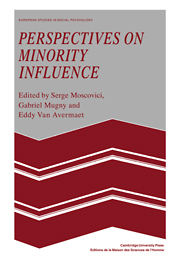Book contents
- Frontmatter
- Contents
- Contributors
- Preface
- Part I The process of minority influence
- Introduction
- 1 Innovation and minority influence
- 2 Social support and minority influence: the innovation effect reconsidered
- 3 Compromising public influence for private change
- 4 Conflict and conversion
- 5 Rigidity and minority influence: the influence of the social in social influence
- Part II Minority influence in groups
- References
- Subject index
- Author index
Introduction
Published online by Cambridge University Press: 05 February 2012
- Frontmatter
- Contents
- Contributors
- Preface
- Part I The process of minority influence
- Introduction
- 1 Innovation and minority influence
- 2 Social support and minority influence: the innovation effect reconsidered
- 3 Compromising public influence for private change
- 4 Conflict and conversion
- 5 Rigidity and minority influence: the influence of the social in social influence
- Part II Minority influence in groups
- References
- Subject index
- Author index
Summary
Work on social influence has been concerned with the multiplicity of situations in which the behaviours, perceptions, opinions, attitudes, etc. of an individual (or group of individuals) are modified by the behaviours, perceptions, opinions and attitudes of another individual (or group of individuals). Two contrasting categories of influence situation can be identified. In the first, the source of influence is a majority, or is attractive or is competent, etc. – in brief, it possesses some resource capable of ensuring its ascendancy over the target of influence. The latter, in a complementary fashion, is a minority or is deviant or is unattractive, or lacks competence. In practice most classic work has studied this side of the coin only, where the dynamics of influence are underpinned by one form or another of dependence which ensures the influence of the superior party and confines the subordinate party to conformity and submission. Certainly, this is sometimes, and perhaps even frequently, the case.
However, a second category of situations can also be envisaged. In this, minority individuals (or groups) viewed as deviant, and to begin with lacking any power, attractiveness, or competence, or indeed any resource capable of inducing dependence, succeed despite all this in modifying what the majority thinks, or in overturning social rules; they succeed in effect in bringing others to share their convictions. In the first chapter Serge Moscovici makes a strong plea for the study of minority influence.
- Type
- Chapter
- Information
- Perspectives on Minority Influence , pp. 3 - 8Publisher: Cambridge University PressPrint publication year: 1985
- 1
- Cited by

